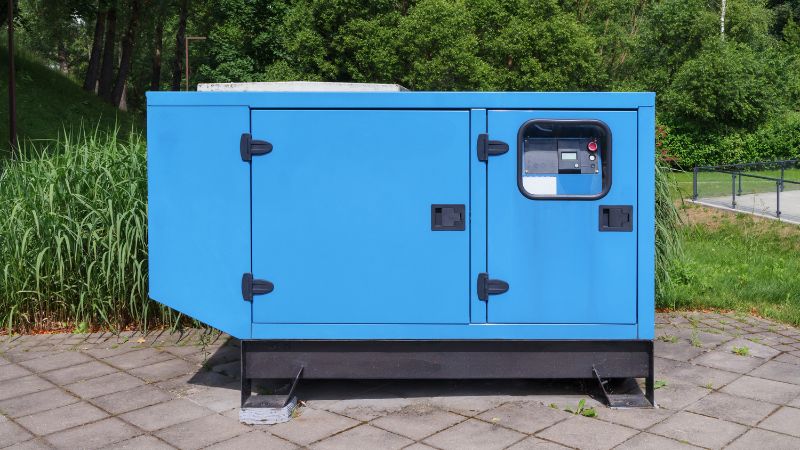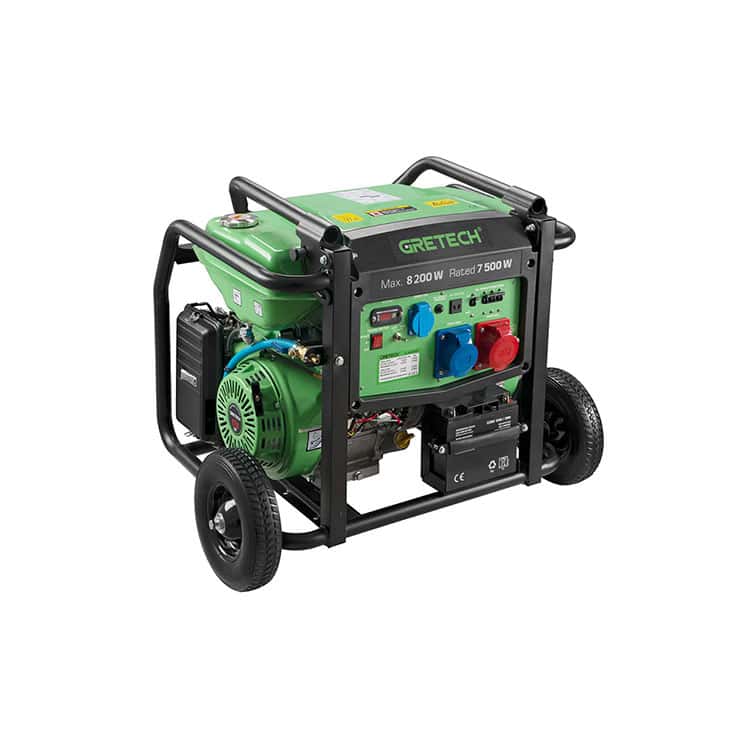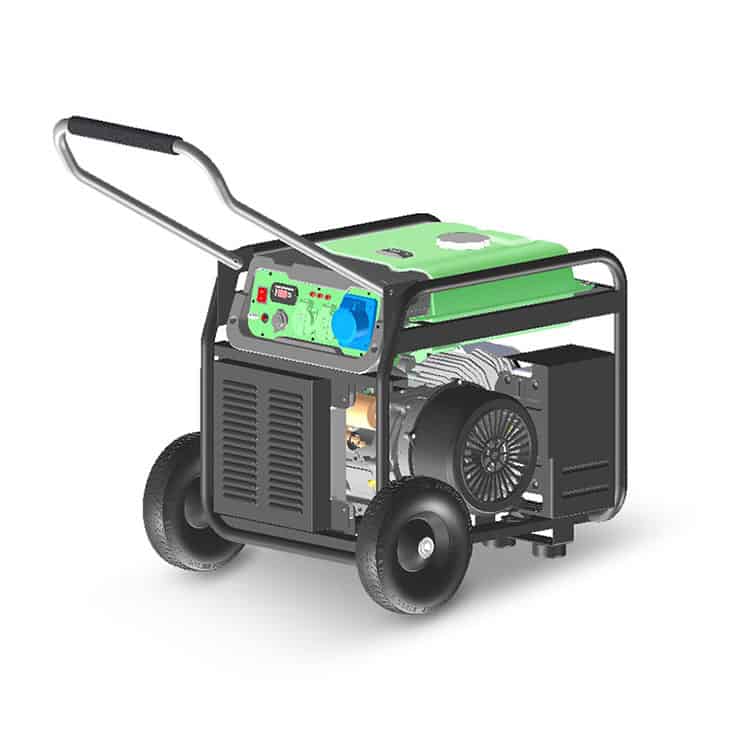
When it comes to choosing a generator for your backup power needs, understanding the difference between single phase and three phase generators is crucial. These two types serve different needs and applications, making it essential to know which generator solution suits your requirements best. Whether you’re powering a home, a small business, or industrial equipment, the right generator can make all the difference.
Single phase generators typically provide a steady and reliable backup power supply for residential use, while three phase generators are designed for more demanding applications, delivering higher efficiency and power output. This article will break down the key differences between the two, helping you make an informed decision for your power needs.
What is a 3-Phase Generator?
A 3-phase generator produces electrical power using three alternating currents. Each phase produces a voltage wave that is offset by 120 degrees. This design leads to more consistent power delivery and smoother operation for electric motors, allowing it to deliver power efficiently to industrial and commercial settings.
These generators are commonly powered by diesel engines, especially in medium to large-scale applications. A diesel generator of this type is prized for its durability, fuel efficiency under load, and ability to provide prime or continuous power for extended periods.
3-phase generators typically come in two types: synchronous and asynchronous. Synchronous generators operate at a constant speed, maintaining a steady frequency. Asynchronous generators, on the other hand, vary in speed and work well with fluctuating loads.
Advantages of 3-phase generators
Key benefits of 3-phase generators include:
- Higher efficiency: 3-phase systems use less conductor material, improving operational efficiency. This is why generators are more efficient in three-phase configurations.
- Reduced fluctuations: The steady output minimizes interruptions, which is critical for sensitive equipment.
- Lower starting currents: Motors connected to 3-phase systems draw less current when starting, reducing strain on the generator.
- Flexibility: 3-phase systems allow you to balance loads across phases, enhancing system reliability.
You can find 3-phase generators in various power ratings, often ranging from 5 kW to over 1 MW, making them suitable for numerous high power applications.
What is a Single-Phase Generator?
A single-phase generator produces electricity using a single alternating current. This type of generator outputs a consistent voltage wave, suitable for residential and light commercial applications. You typically find single-phase generators in homes, powering appliances like refrigerators, lights, and HVAC systems.
While smaller single-phase generators are often gasoline-powered, larger models designed for home standby or small business backup are frequently diesel generators. These single-phase diesel models offer better fuel economy and longer engine life for frequent or prolonged use.
Single-phase generators operate with two wires: a live wire and a neutral wire. This configuration delivers power in a simple manner, making installation and maintenance less complex. The maximum output usually ranges from 1 kW to 10 kW, sufficient for everyday household use.
Advantages of single-phase generators
Key benefits of single-phase generators include:
- Simplicity: Design and operation are straightforward, facilitating easy installation.
- Cost-Effectiveness: Generally, single-phase generators cost less than their three-phase counterparts.
- Space Efficiency: Models are often more compact, fitting conveniently in limited spaces.
Single-phase generators are ideal for applications requiring moderate power levels and steady electricity, making them a dependable choice for numerous residential needs.
Key Differences Between Single-Phase and Three-Phase Power
Here are 7 main differences between single and three-phase power.
- Number of Phases: Single-phase power consists of one alternating current, while three-phase power contains three alternating currents, each phase separated by 120 degrees.
- Power Delivery: Single-phase generators provide power in a single wave, leading to fluctuations. Three-phase generators offer smoother power delivery, reducing these fluctuations and enhancing performance.
- Efficiency: Single-phase systems are less efficient for large loads, typically supporting up to 10 kW. In contrast, three-phase systems operate more efficiently, supporting higher loads, often exceeding 100 kW, making them suitable for industrial applications.
- Starting Torque: Single-phase motors have lower starting torque, which can impact performance in heavy applications. Three-phase motors generate higher starting torque, ensuring effective operation for heavy machinery.
- Complexity of Installation: Single-phase systems are simpler, requiring only two wires, which makes installation easier. Three-phase systems involve more complexity due to additional wiring, but they offer improved load balancing.
- Cost Consideration: Single-phase generators typically cost less upfront compared to three-phase generators. However, for larger applications, the operational efficiency of a three-phase generator often leads to long-term savings.
- Load Balancing: Load balancing in single-phase systems can be inconsistent, potentially leading to overloads. Three-phase systems allow for better load distribution, minimizing the risk of overload and enhancing overall stability.
Applications of Single-Phase and 3-Phase Power
Here are specific applications of each power:
Three-Phase Generators
- Industrial Machinery: Large motors, pumps, compressors, conveyor systems, and manufacturing equipment.
- Commercial Buildings: Office towers, shopping malls, hospitals, and data centers for powering HVAC systems, elevators, and large electrical loads.
- Construction Sites: To run heavy equipment like welders, large drills, and cranes.
- Large Farms and Agriculture: For running irrigation pumps, grain silos, and processing equipment.
- Power Plants: All utility-scale generators (hydro, thermal, wind, solar farms) produce three-phase power.
- Marine and Mining: For large-scale propulsion and extraction equipment.
Single-Phase Generators
- Home Backup Power: Portable generators and home standby generators for powering refrigerators, lights, fans, and small appliances during an outage.
- Small Businesses: Shops, small offices, and food trucks.
- Recreational Use: Camping, RVing, and tailgating with small portable inverters.
- Construction & DIY: Powering small tools like drills, saws, and lights at a job site.
- Remote Locations: Providing power for cabins or small workshops.
Choosing Between Single and Three-Phase Generators
Choosing between 3-phase and single-phase generators depends on your specific power needs and applications.
Consider Your Power Requirements
Assess the total power demand in kilowatts (kW). Single-phase generators typically operate effectively in the range of 1 kW to 10 kW, suitable for residential appliances like refrigerators, lights, and HVAC systems. Three-phase generators handle higher loads, often exceeding 100 kW, making them ideal for industrial settings with machinery and heavy equipment.
Evaluate Your Application
Identify the application type. If you’re powering residential setups, single-phase generators simplify operation and reduce initial costs. For commercial or industrial use, three-phase generators provide improved efficiency and performance, ideal for applications requiring higher starting torque and continuous power delivery.
Installation Considerations
Examine the installation complexity. Single-phase generators require fewer connections and simpler wiring, easing the setup process. Conversely, three-phase generators might necessitate specialized installation skills but yield long-term operational savings through enhanced efficiency.
Analyze Cost Efficiency
Compare the cost-effectiveness of both generator types. Single-phase generators generally present lower upfront costs but maintain efficiency only for moderate usages. Three-phase generators involve a higher initial investment yet deliver better fuel efficiency and reliability, leading to cost savings over time.
Long-term Flexibility
Think about future needs. Three-phase generators offer greater flexibility in scaling power supply as your business or household energy demands grow. Single-phase generators serve well for standard residential usage but may require upgrading for expanded power needs.
By evaluating power requirements, application types, installation considerations, cost efficiency, and long-term flexibility, you can make an informed decision that best suits your generator needs.
Gretechpower’s Single / 3 Phase Generators
Single/3 Phase Inverter Generator, LPG/NG/Petrol

Main Advantages:
- Powerful performance with high output versatility
- Compatible with multiple fuel types
- Configurable voltage options for diverse applications
- Efficient fuel consumption across different fuels
- Convenient starting system with recoil and electric options
- Enhanced safety features including low oil alert
- Stable electrical output with built-in AVR
- Durable construction and lightweight design for easy transport
- Extended operation time with a large fuel tank capacity
- Compliant with key safety and noise regulations
Single Phase Generator for Home, Hybrid,LPG/NG/Petrol

Main Advantages:
- Delivers up to 10,000 watts for strong home performance
- Compatible with LPG, natural gas, and petrol
- Supports 110V-240V and 50Hz/60Hz systems
- Easy operation with recoil and electric start
- Low consumption for enhanced value
- Powered by a reliable 17HP JL460 engine
- Operates at 68 dB, suitable for residential use
- Features a low oil alert to prevent damage
- Compliant with CE, EU5, and noise regulations
- Weighs 75 kg and has compact dimensions for transport
Frequently Asked Questions
Which is better, a single-phase or a three-phase generator?
Single-phase generators are generally more affordable and suitable for residential use, powering low-demand appliances. In contrast, three-phase generators offer better efficiency and can handle higher loads, making them ideal for industrial applications requiring significant power.
Can a three-phase generator be used for single-phase?
Yes, a three-phase generator can be configured to run as a single-phase generator. This involves reconfiguring the connections of the stator windings to draw power from just one or two of its three phases.
What are the advantages of a single-phase generator?
Single-phase generators are easier to install and require less initial investment, making them cost-effective for residential or light commercial use. They provide reliable, steady power for typical household appliances and operations.
How do I know if my building or equipment requires three-phase power?
The best way is to check your main electrical panel or the data plate on your large equipment (like an HVAC compressor, large motor, or industrial machine). A three-phase service will have three main live busbars (often labeled L1, L2, L3) or a three-pole main breaker. Equipment will state a voltage like “208V/240V 3-phase” or “480V 3-phase.” If you are unsure, consult a licensed electrician.
Is the maintenance different for single-phase vs. three-phase generators?
The maintenance of the engine (oil, filters, coolant) is largely the same. The difference lies in the electrical components. Three-phase generators have more complex alternators with more windings and connections, which may require more sophisticated testing and maintenance by a technician familiar with three-phase systems. The overall maintenance schedule, however, is similar.
